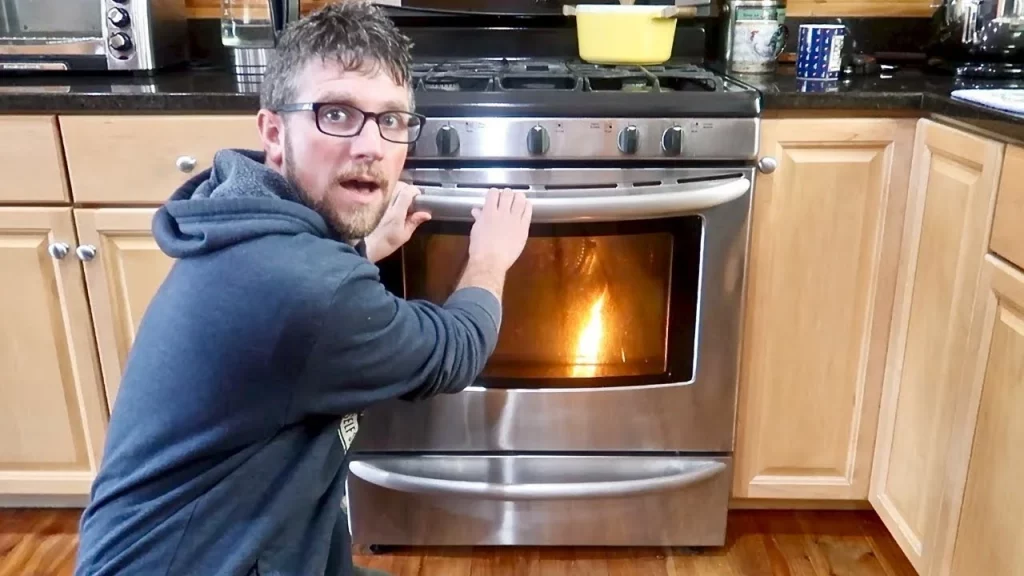Oven fires can be a terrifying and potentially dangerous situation in the kitchen. While they don’t occur frequently, it’s essential to be prepared and know how to respond effectively in case a fire breaks out in your oven. This article will guide you through the steps to deal with an oven fire safely and efficiently.

Immediate Actions
- Stay Calm: The first and most crucial step is to stay calm. Panic can lead to poor decision-making. Keep a clear mind to address the situation.
- Keep the Door Closed: If you notice flames inside the oven, do not open the oven door. Opening the door can allow oxygen to feed the fire and cause it to spread.
- Turn Off the Oven: If it’s safe to do so, turn off the oven immediately. This will cut off the heating element’s power supply.
- Unplug the Oven: If the fire continues, unplug the oven from the electrical outlet. This will ensure the oven is completely disconnected from its power source.
Types of Oven Fires
Understanding the type of fire can help you determine the appropriate actions:
- Small Flame in the Oven: If the fire is relatively small and contained within the oven, it may be caused by spilled food or grease. In this case, keeping the door closed and turning off the oven should extinguish the fire.
- Grease Fire: If the fire involves burning grease, do not use water to extinguish it. Water can cause the grease to splatter and spread the fire. Instead, use a fire extinguisher or cover the pan with a metal lid or cookie sheet.
- Electrical Fire: If the fire originates from an electrical issue within the oven, it’s essential to keep the door closed, turn off the oven, and unplug it. Do not attempt to extinguish an electrical fire with water.
Dealing with Smoke and Odor
After extinguishing the fire, you may be left with smoke and odor issues.
How to Address Residual Smoke and Smell
- Ventilation: Open windows and use fans to clear out smoke and odors from your kitchen.
- Neutralize Odors: Use odor-neutralizing products or natural remedies like vinegar or lemon to eliminate unpleasant smells.
- Inspect for Damage: Examine your oven for any damage or residue. Clean it to prevent further issues.
Common Causes of Oven Fires
Identifying the culprits behind oven fires is crucial for prevention. Here are some common causes and solutions to mitigate the risk:
Food Residue and Grease
Cause: Over time, food residue and grease can accumulate in your oven, especially if not cleaned regularly. When exposed to high temperatures during cooking, this buildup can ignite and lead to a fire.
Faulty Wiring
Cause: Faulty or damaged wiring in your oven can create a fire hazard. Over time, wear and tear on the wiring can lead to electrical fires.
Cookware Mishaps
Cause: Using the wrong cookware or experiencing mishaps with cookware, such as spills and drips, can lead to oven fires. Shallow pans or pans with irregular surfaces can cause spills that ignite when in contact with the heating element.
Troubleshooting Oven Fire Causes
Understanding the root causes of oven fires is the first step in addressing the issue effectively. Here’s a systematic guide to diagnosing and resolving oven fire causes:
1. Identifying the Type of Fire:
Understanding the nature of the fire is crucial for choosing the appropriate response. Here are some common types of oven fires:
- Food Fire: This type of fire occurs when food debris or grease inside the oven ignites. It often leads to flames inside the oven.
- Electrical Fire: Electrical fires may result from faulty wiring, damaged heating elements, or electrical components. These fires are often accompanied by sparks and smoke.
- Smoke Fire: Smoke fires can occur due to food spillage on the oven’s heating element. While it doesn’t always result in visible flames, it can produce significant smoke and odor.
- Exterior Fire: In rare cases, the fire may originate from outside the oven, such as a kitchen fire spreading to the appliance.
2. Assessing Damage:
Examine your oven for any damage or malfunction that may have contributed to the fire. Here’s what you can do:
- Check the oven’s interior for signs of damage, including charred or melted components.
- Inspect the oven door’s seal to ensure it’s intact and can effectively contain heat and flames.
- Examine the heating elements, racks, and oven walls for any visible damage.
- Pay attention to the control panel and buttons to check for any anomalies or signs of malfunction.
3. Inspecting Wiring:
Faulty or damaged wiring can be a major contributor to oven fires, particularly in electrical fires. Here’s how to inspect the oven’s wiring:
- Safety First: Before inspecting the wiring, ensure the oven is unplugged and disconnected from the electrical supply.
- Visual Inspection: Carefully examine the oven’s wiring for any visible damage, fraying, or loose connections. Inspect the power cord and wiring inside the oven.
- Professional Assessment: If you notice any damage or are unsure about the condition of the wiring, it’s advisable to consult a professional technician for assessment and repairs.
Action After The Fire
- Cleaning Residue: After assessing the damage, it’s crucial to clean your oven thoroughly to remove any residue or damage caused by the fire. Use appropriate cleaning materials and methods recommended by the oven’s manufacturer. Ensure that the oven is completely cool before starting the cleaning process.
- Regular Maintenance: To prevent further incidents and maintain the oven’s functionality, perform regular maintenance. This includes routine cleaning to prevent the buildup of food residue and grease, which can be potential fire hazards. Follow the manufacturer’s guidelines for maintenance to keep your oven in good working condition.